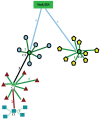A Formal Energy Consumption Analysis to Secure Cluster-Based WSN: A Case Study of Multi-Hop Clustering Algorithm Based on Spectral Classification Using Lightweight Blockchain
- PMID: 36298079
- PMCID: PMC9607056
- DOI: 10.3390/s22207730
A Formal Energy Consumption Analysis to Secure Cluster-Based WSN: A Case Study of Multi-Hop Clustering Algorithm Based on Spectral Classification Using Lightweight Blockchain
Abstract
Wireless Sensors Networks are integrating human daily life at a fast rate. Applications cover a wide range of fields, including home security, agriculture, climate change, fire prevention, and so on and so forth. If WSN were initially flat networks, hierarchical, or cluster-based networks have been introduced in order to achieve a better performance in terms of energy efficiency, topology management, delay minimization, load balancing, routing techniques, etc. As cluster-based algorithms proved to be efficient in terms of energy balancing, security has been of less importance in the field. Data shared by nodes in a WSN can be very sensitive depending on the field of application. Therefore, it is important to ensure security at various levels of WSN. This paper proposes a formal modeling of the energy consumed to secure communications in a cluster-based WSN in general. The concept is implemented using the Proof of Authentication (POAh) paradigm of blockchain and applied to a Multi-hop Clustering Algorithm based on spectral classification. The studied metrics are residual energy in the network, the number of alive nodes, first and last dead node.
Keywords: clustering; cryptography; energy; security; wireless sensors network.
Conflict of interest statement
The authors declare no conflict of interest. The funders had no role in the design of the study; in the collection, analyses, or interpretation of data; in the writing of the manuscript, or in the decision to publish the results.
Figures













References
-
- Zeb A., Islam A.K.M.M., Zareei M., Mamoon I.A., Mansoor N., Baharun S., Katayama Y., Komaki S. Clustering Analysis in Wireless Sensor Networks: The Ambit of Performance Metrics and Schemes Taxonomy. Int. J. Distrib. Sens. Netw. 2016;12:4979142. doi: 10.1177/155014774979142. - DOI
-
- Shahraki A., Taherkordi A., Haugen Ø., Eliassen F. Clustering Objectives in Wireless Sensor Networks: A Survey and Research Direction Analysis. Comput. Netw. 2020;180:107376. doi: 10.1016/j.comnet.2020.107376. - DOI
-
- Akila I.S., Manisekaran S.V., Venkatesan R. Modern Clustering Techniques in Wireless Sensor Networks. In: Sallis P., editor. Wireless Sensor Networks. Volume 6. IntechOpen; Rijeka, Hrvatska: 2017. pp. 121–130.
-
- Heinzelman W.R., Chandrakasan A., Balakrishnan H. Energy-Efficient Communication Protocol for Wireless Microsensor Networks; Proceedings of the 33rd Annual Hawaii International Conference on System Sciences; Maui, HI, USA. 4–7 January 2000; - DOI
-
- Bandyopadhyay S., Coyle E.J. An Energy Efficient Hierarchical Clustering Algorithm for Wireless Sensor Networks; Proceedings of the IEEE INFOCOM 2003. Twenty-Second Annual Joint Conference of the IEEE Computer and Communications Societies (IEEE Cat. No.03CH37428); San Francisco, CA, USA. 30 March–3 April 2003; pp. 1713–1723.
MeSH terms
LinkOut - more resources
Full Text Sources
Research Materials

